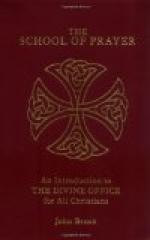Sunday’s hymn, Lucis Creator optime, stands thus in translation:—
“O blest Creator
of the light,
Who makest the
day with radiance bright,
And o’er
the forming world didst call
The light from
chaos first of all.
Whose wisdom joined
in sweet array
The morn and eve
and named them day,
Night comes with
all its darkening fears;
Regard Thy people’s
prayers and tears,
Lest sunk in sin,
and whelmed with strife,
They lose the
gift of endless life;
While thinking—but
the thoughts of time,
They weave new
chains of woe and crime.
But grant them
grace that they may strain
The heavenly gate
and prize to gain;
Each harmful lure
aside to cast,
And purge away
each error past.
O Father, that
we ask be done,
Through Jesus
Christ, Thine only Son;
Who, with the
Holy Ghost and Thee,
Doth live and
reign eternally. Amen.”
(Translation by Dr. J.M. Neale).
Structure. Vespers, in structure, resembles Lauds and consists of five Psalms. It begins with Pater Noster, Ave (said silently), Deus in adjutorium,... Domine ad adjuvandum.... Gloria Patri.... Sicut erat. Alleluia or Laus tibi.... Antiphon begun only if the feast be not double; if feast be a double the antiphon is said in full before and after each psalm. If feast be a semi-double or simple the antiphon is intoned at the beginning and is said in full at end of each psalm and then only. Then are said Capitulum, Deo gratias, Hymn, versicle and response, antiphon to Magnificat, the canticle Magnificat, Gloria Patri.... Sicut erat.... Dominus vobiscum.... Et cum spiritu tuo, Oremus, collect, commemoration if any made by versicle and response and antiphon of Magnificat proper to commemoration with collect, Dominus vobiscum, Et cum.... Benedicamus Domino; Deo gratias, Fidelium animae.... Amen. If Compline be not said immediately after Vespers, Pater Noster is added.
At the opening words of the Magnificat, Nunc Dimittis and Benedictus, it is a practice with many priests to make the sign of the cross from forehead to breast, as at Deus in adjutorium (cf. Ceremoniale Epis. lib. II. i. 14). This custom, where it exists, should be preserved (S.R.C., April, 1867).
Writers on liturgy tell us that the number of Psalms in Vespers have a symbolic meaning, typifying the five wounds of the Saviour, the last of which, the wound in the side, was inflicted on the evening of Good Friday, and the others, as the Church says in the hymn Vergente mundi vespere, at the waning of the day of the Old Law, before the dawn of salvation (Honorius of Autun, circa 1130). Other writers say that these five psalms should produce acts of contrition for the sins committed during the day, by the five senses; and that they should be for us, morally, what the five lighted lamps were for the wise virgins in the Gospel parable (Amalare of Metz, circa 850).




